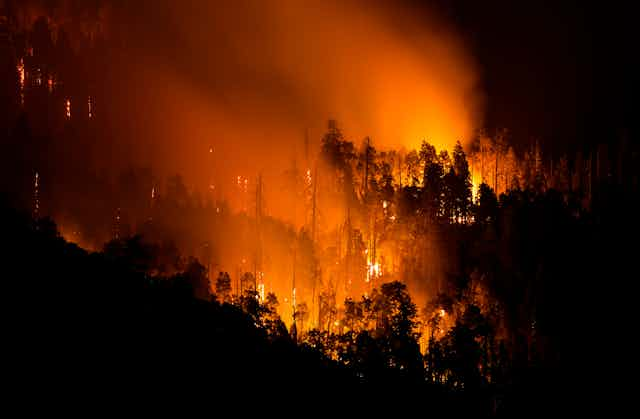In recent years, Californians have had to deal with some deadly and destructive wildfires. But in fact, this part of the western United States has been shaped by fire for millennia.
In this episode of The Conversation Weekly podcast, we hear about new research from California into a decades-old mystery: the extinction of large animals at the end of the Ice Age. It’s providing some worrying lessons from history about the way humans, fire and ecosystems interact.
In a park in the middle of Los Angeles lies one of the most important fossil sites in the world – the La Brea Tar Pits. The park sits atop a natural oil reserve. Regular earthquakes in the area opened up fissures in the ground, bringing some of that oil to the surface where it sits in pools of tar, or asphalt.
“The asphalt is so sticky that if you were to walk in there, you would not be able to get out without help if you were to get both of your feet stuck. And so that’s what happened over the last part of the Ice Age,” explains Emily Lindsey, a paleoecologist and associate curator at La Brea Tar Pits who also works at the University of California, Los Angeles.
This was a period when large animals roamed the Earth – including, in the area of modern-day California, mammoths, giant ground sloths, sabre-tooth cats and dire wolves. Many of these animals got trapped in the tar pits at La Brea, where their bodies provide a unique fossil record of the animals that moved through the area during the Ice Age – until, that is, about 13,000 years ago, says Lindsey.
What’s unique about the Ice Age is that at the very end of it, after more than 50 million years of having big animals in all global ecosystems, most of those animals went extinct – most of the big ones. And it happened very rapidly.
The cause of this mass extinction has been debated by scientists for decades. In new research, Lindsey and her colleagues decided to use the fossil records at La Brea, combined with sediment records from a nearby lake, to pinpoint exactly when the extinctions took place in California – and what else was happening at the time.
They found that in the 2,000 years leading up to the extinction event, the climate in southern California was warming rapidly, and drying out.
And then 200 years before the extinction event, about 13,200 years ago, we see something very unusual happen. Everything catches on fire.
Lindsey and her team argue that alongside the warming climate, it was humans – whose populations began to expand in this part of North America at around this time – who probably ignited these fires, which eventually led to the extinction of California’s big animals. The findings, she says, are “eerily similar” to what’s happening in the area today.
Listen to The Conversation Weekly podcast for the full interview with Emily Lindsey, plus some insights on the current state of wildfires in North America from Stacy Morford, environment and climate editor at The Conversation in the US.
A full transcript of this episode is now available.
This episode was written and produced by Katie Flood. Eloise Stevens does our sound design, and our theme music is by Neeta Sarl. Gemma Ware is the executive producer of the show.
Newsclips in this episode are from CBS Evening News and NBC News.
You can find us on X, formerly known as Twitter @TC_Audio, on Instagram at theconversationdotcom or via email. You can also subscribe to The Conversation’s free daily email here.
Listen to The Conversation Weekly via any of the apps listed above, download it directly via our RSS feed or find out how else to listen here.

